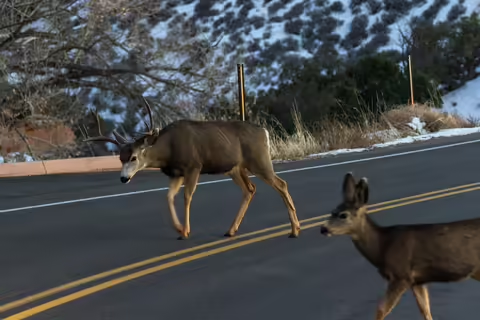Drivers should slow down and stay alert to avoid deer-vehicle collisions this fall. Most deer-vehicle accidents occur during the months of October, November, and December during the hours of 5 to 10 p.m. and 5 to 9 a.m. State Farm of Illinois suggests that Illinois drivers have a 1 in 144 chance of colliding with a deer on the road in 2018-19.
Doug Gucker, University of Illinois Extension Educator for Agriculture and Small Farms reminds drivers to “watch for deer on our rural roads during fall mating season if you are traveling after dark.” Gucker also offers this tip, “If you see one deer crossing the road ahead of you, slow down because deer usually travel in groups.”
Not all deer-vehicle accidents can be prevented, but wildlifeillinois.org provides drivers with some tips that may help avoid an accident:
-
Be aware of your surroundings. Pay attention to deer crossing signs and scan the roadsides for the “eyeshine” which is the reflection of headlights in the deer’s eyes.
-
At night, use your high-beam lights when appropriate. This may allow you to see the deer a few seconds earlier, giving you enough time to avoid an accident.
-
Deer often use woodlots, fencerows, field edges or areas near water. Extra caution is needed when these habitats are close to roadways.
-
Slow down around curves in areas where deer are known to occur.
-
Deer will often follow one another single file across a road. Trying to cross through the middle of such a group often results in deer colliding with the side of the vehicle.
-
If there are deer near the road, slow down, honk the horn in short bursts and flash the headlights. Tap the brakes or use the emergency flashers to alert other drivers. Prepare to safely stop if the deer move toward the roadway.
-
If there are deer on or approaching the road, do not slam on the brakes or swerve sharply to avoid the deer. It is instinctual to do this but doing so may cause a loss of control of the vehicle and a more severe accident.
May and June are also peak times for deer-vehicle accidents as one-year old deer are dispersing to new areas. However, it is important to remember that accidents can happen at any time of year.
